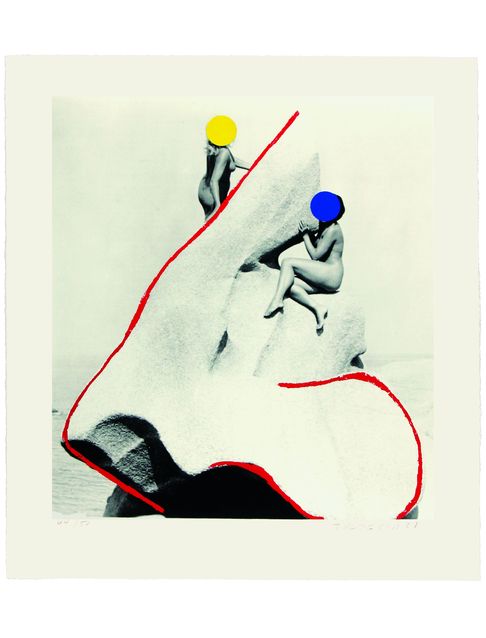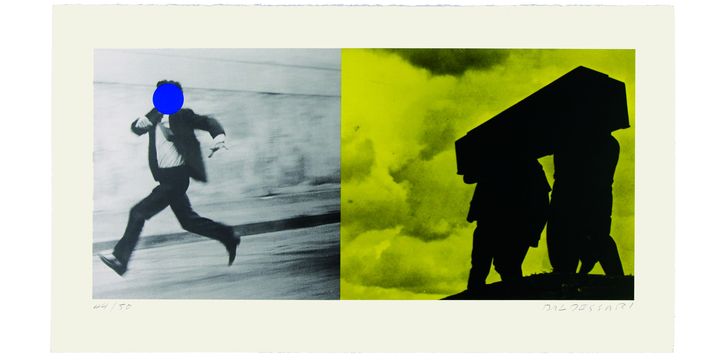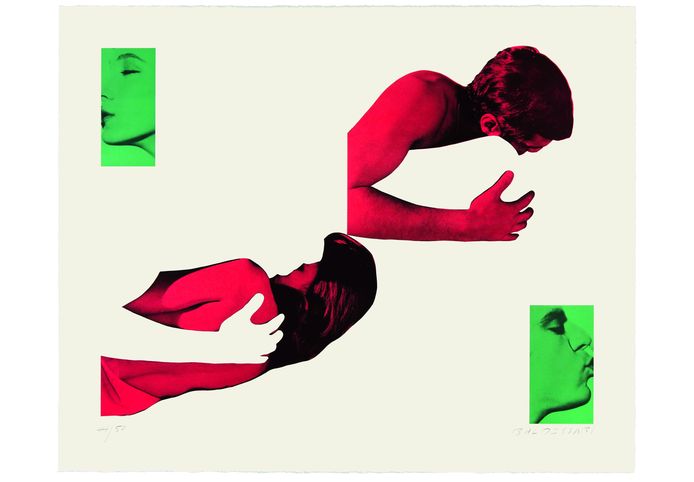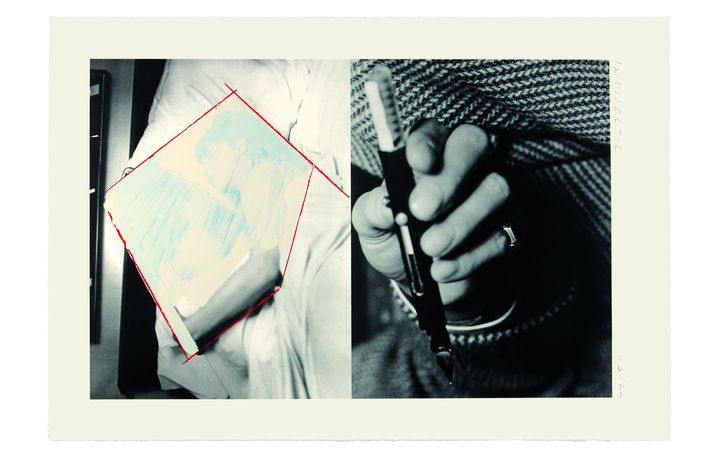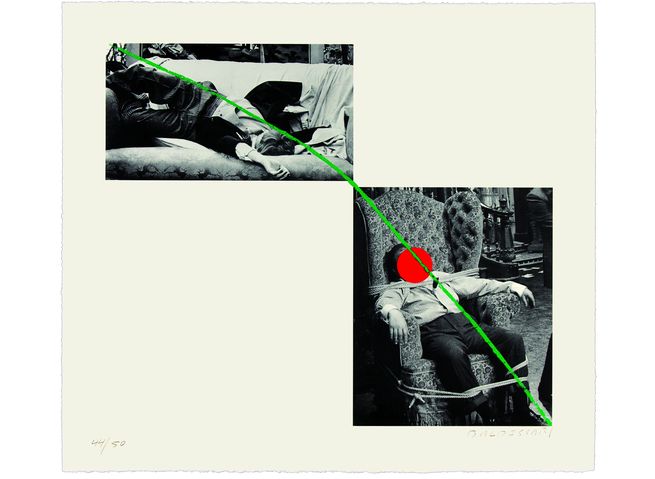Folder with five lithographs on handmade paper
Dimensions: 42 x 74.5 cm; 63 x 57 cm; 75 x 51.7 cm; 56.5 x 69.2 cm; 57 x 70 cm
Signature, inscriptions, markings: signed at lower right, numbered at lower left
Copy Number: 44/50
Printer: Donald Farnsworth and Rick Dula
Editor: Magnolia Editions, Oakland
Publisher: The Arion Press, San Francisco
Accession Number: 1002450.1–6
"When I read Tristram Shandy, I thought, my God, the man is like you. He jumps from one form to another."1 In 1988, John Baldessari annotated the whimsical nine-volume work by English writer Laurence Sterne The Life and Opinions of Tristram Shandy, Gentleman (1759-67) with 39 photocollages.2 In fact, both artists have quite a bit in common. By combining photography, painting, and linguistic elements, Baldessari wants to trigger associative processes in the viewer, to direct them, but also to question them; Sterne's erratic narrative style seems to correspond to an associative thought connection.
Next to Sterne, Baldessari's art seems almost comical, although he himself says: "I never try to be funny. It's merely a certain way of looking at things. Or trying not to overlook things.3 But even in Sterne's book, which has autobiographical overtones, seriousness and comedy are close together when the first-person narrator, Tristram Shandy, wants to lay out his supposedly failed life and blames the circumstances for it, which he describes in detail. Thus, the contents of the book are digressive anecdotes and the fixed ideas of the various characters in the novel.
The illustrated lithograph The Promontory of Noses refers to a specific passage in the text (Book IV, Chapter 0, p. 237) and takes up a theme introduced by the character of Tristram's father. The latter loses himself in constant theorizing and hypothesizing, which, however, never once prove themselves in practical application. One of these quirky theories is the "nose theory," according to which he sees a connection between the length of the nose and social success. He deals extensively with a study on the causes of long and short noses, the scientific seriousness of which is not devoid of a certain comicality. The ambiguity of this thesis is obvious and is reinforced by the fact that it is repeatedly and emphatically denied. Baldessari further emphasizes the ambiguous aspect by using a black and white photograph that shows two naked women posing on a rock that is identified as a nose by a red outline. While Sterne describes backstories and trivialities in such detail that the reader is constantly, but unsuccessfully, waiting for the author to finally "get to the point," in Baldessari's picture some of the most expressive motifs, the women's faces, are covered by circular colored dots. While Sterne forms his figures into very individual personalities, Baldessari makes them into types.4 By "omitting essential information,"5 one of the guidelines in Baldessari's art, he wants to sharpen the viewer's eye for the incidental and the surroundings; he does not want to "give the viewer what he wants, but force him to think about what is there."6 The tension between the three-dimensional reality depicted in the black-and-white photograph and the two-dimensional colored circular areas, that is, between visible things and the invisible, unsettles and provokes a second look. It is precisely the obscured areas that attract attention and allow the viewer to speculate. The secondary literature on Tristram Shandy puts it in a similar way: "It is not the things themselves that unsettle people, but the opinions about the things."7
Sarah Wittig
1 John Baldessari, quoted from: Cat. of Exhibit. Baldessari. While something is happening here, something else is happening there. Works 1988-1999, Sprengel-Museum Hannover / Staatliche Kunstsammlungen Dresden, Cologne 1999, p. 25.
2 In conjunction with this edition of Tristram Shandy, our Suite of Five Lithographs was also published.
3 John Baldessari, quoted from: Cat. of Exhibit. John Baldessari. Life's Balance. Werke 84-04, ed. by Peter Pakesch, Kunsthaus Graz am Landesmuseum Johanneum, Cologne 2005, p. 99.
4 Cf. cat. Baldessari 2005, p. 62 ff.
5 Cf. cat. Baldessari 2005, p. 84.
6 John Baldessari, quoted from: Cat. of Exhibit. John Baldessari: Somewhere between almost right and not quite (with orange), Deutsche Guggenheim Berlin, Ostfildern-Ruit 2004, p. 54.
7 Joachim Blum, Things and Opinions in Tristram Shandy, Trier 2001, p. 67.
